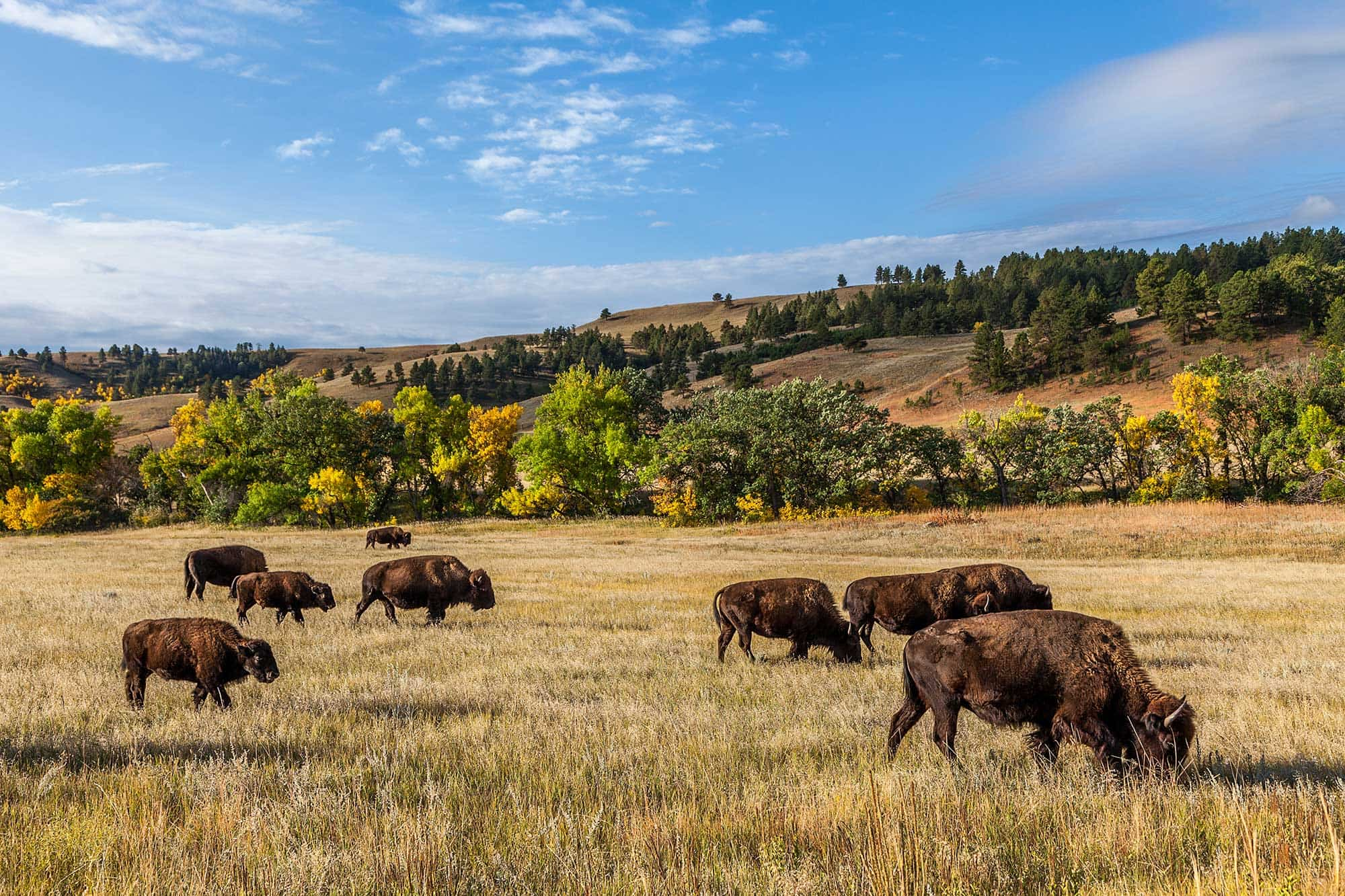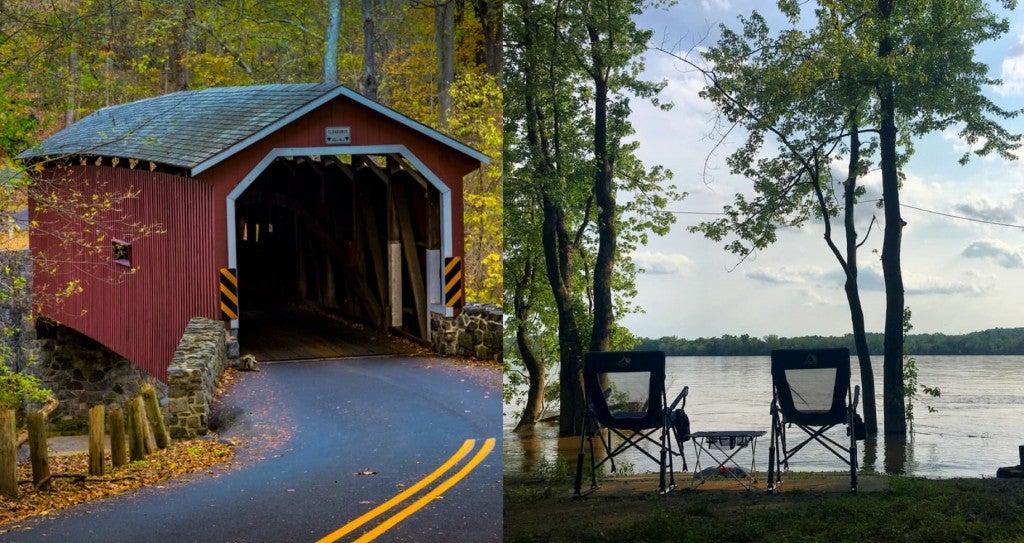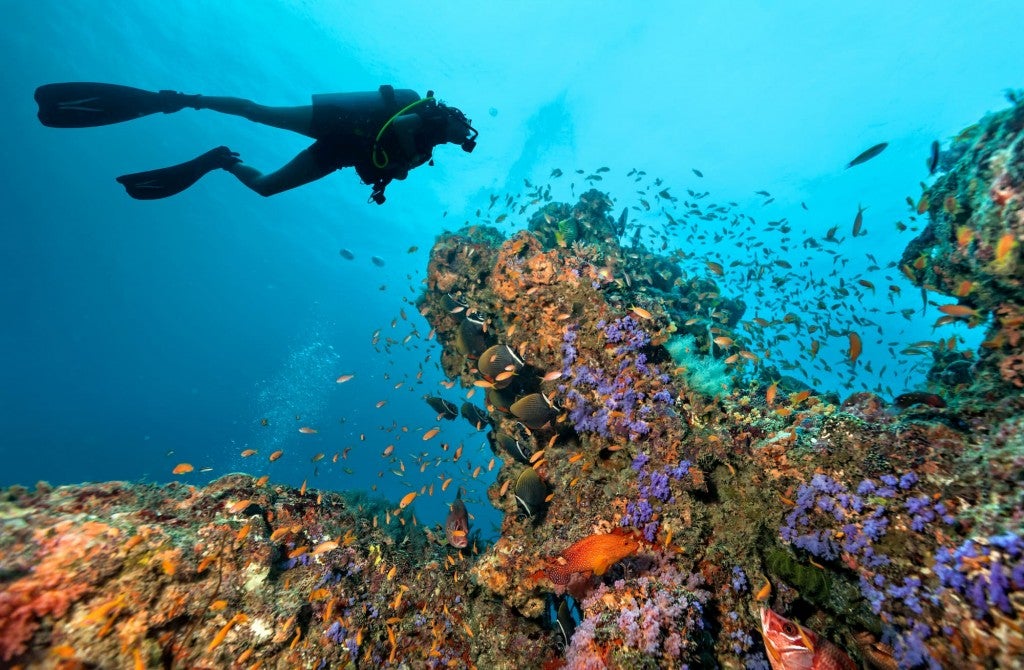Peter Norbeck, former Governor of South Dakota and “Father of Custer State Park,” once shared his musings on Custer State Park’s twisty, turny roads, which he helped envision with state engineer Scovel John (and a lot of dynamite): “You’re not supposed to drive here at 60 miles an hour; to do the scenery justice, you should drive at no more than 20. To do it full justice, you should just get out and walk it.”
The first time I reached the Needle’s Eye along Custer State Park’s 14-mile Needles Highway, I heeded that advice, parking the car at a pullout to view the unique rock formation by foot. It was my first trip through Custer State Park after moving to South Dakota’s Black Hills. I still remember the awe I felt taking in its beauty.
Campers Love the Beauty and History of Custer State Park
At about 71,000 acres, Custer State Park is the largest state park in South Dakota — in fact, it’s one of the largest in the country. The park entices its visitors with rich history and diverse landscape—rolling prairie with roaming bison, granite boulders surrounding pristine lakes, scenic vistas following rewarding hikes.
After making the region my home, I quickly learned that I was not the only one who had experienced a bit of love at first sight for the public land. Custer State Park is the life force of small communities that surround it. Locals take great pride in the land and the amenities it offers.
Throughout the summer, I often hear locals talking excitedly about the park to visitors from around the world, offering their insider takes on all the park’s must-sees. It’s this South Dakota hospitality and warmth combined with the natural beauty that leaves a lasting memory for the people who make the trip here.
How Custer State Park Became South Dakota’s First State Park
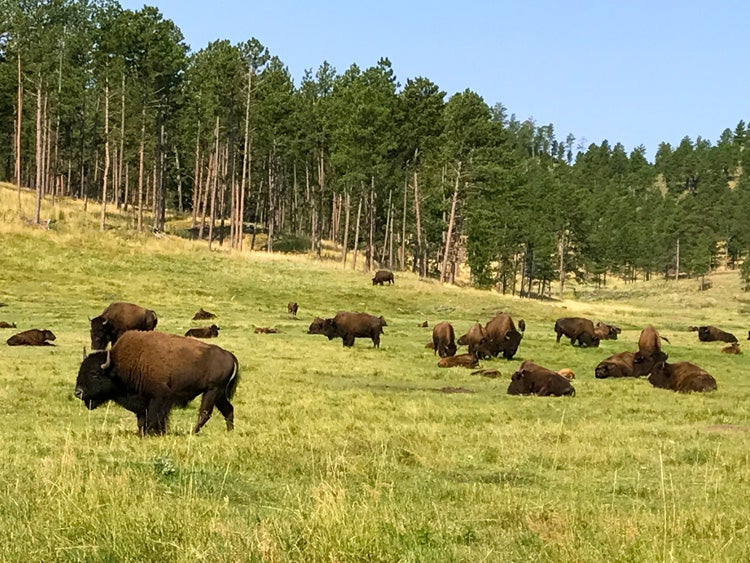
Image from The Dyrt camper Kathy M.
Peter Norbeck first visited what would become Custer State Park in 1905 when he and a friend loaded up their Cadillac in Fort Pierre, South Dakota, and headed west through many areas that still remained roadless at that time. As soon as he arrived in the region, he latched on to the idea that this land should be preserved in a way for people to appreciate its wildlife and natural features for generations to come.
By 1912, after Norbeck was elected to the South Dakota State Senate, South Dakota negotiated with the U.S. Forest Service to secure ownership of 48,000 continuous acres in Custer County. South Dakota designated this land as Custer State Forest, which would then become Custer State Game Preserve.
In 1919, Norbeck was elected Governor and saw a unique opportunity to move this land to a new level of protection. He urged the state legislature to create a permanent state park out of the game preserve. By March 1, 1919, Custer State Park was born, the first state park in South Dakota.
In a 1921 speech to the First National Conference on State Parks, Norbeck reflected on the magnitude of this achievement: “Parks are not merely picnicking places. They are rich storehouses of memories and reveries. They are bearers of wonderful talks to him who will listen, a solace to the aged, and an inspiration to the young. A state park cannot be planned until it is found.”
Custer State Park celebrates its 100th birthday in 2019. Its nearly 2 million visitors per year continue to benefit from the inspiration Norbeck found on his first epic road trip to the land.
What Makes Custer State Park Such a Special Place
From wildlife to hiking, history to lakeside lounging, Custer State Park is a special place for the wide array of activities and landscape it affords its visitors.
Wildlife

Wild burrows in Custer State Park.
Custer State Park is an excellent place for wildlife sightings. Throughout the park, visitors can expect to see a range of animals along the trails and roadways, including: coyotes, elk, mule deer, white-tailed deer, pronghorns, prairie dogs, bighorn sheep and mountain goats.
Two of the most iconic wildlife species of the park—bison and burros—can be found along the park’s Wildlife Loop. This 18-mile paved road takes visitors through the open grasslands and rolling hills of the park. It takes about an hour to travel and is open year-round.
During the winter months, you might find yourself in a bit of a bison jam on the Wildlife Loop, as these large, majestic animals like to lick the salt off the roads (and your car!) during the off-season. During the spring, you’ll find the prairie speckled with “cinnamons,” or joyous, frolicking baby bison.
As for the burros, you’ll quickly learn why they’re the namesake for the Beggin’ Burro Mexican Bistro in Custer, South Dakota. These loving donkeys come right up to park visitors for petting and feeding. Children love the iconic burros of Custer State Park, but it’s always important to remember that they are still technically wild animals; visitors should interact with them at their own risk.
Scenic Drives
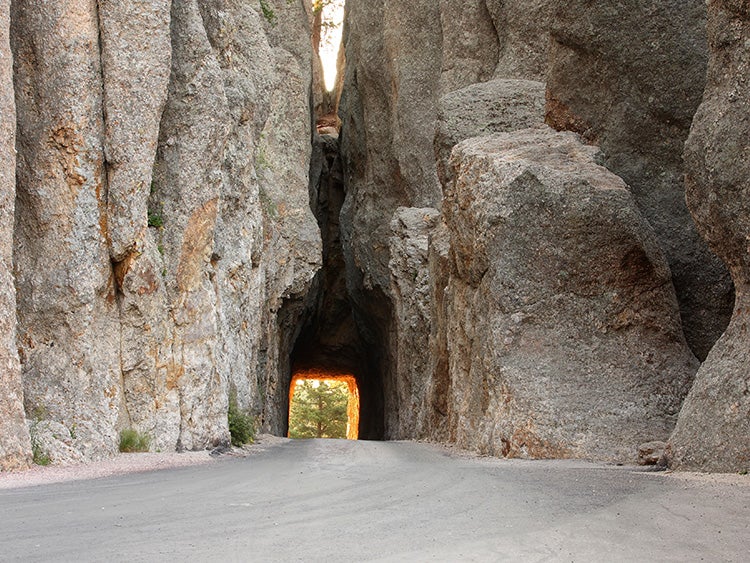
Needles Eye Tunnel at Custer State Park.
Norbeck wanted Custer State Park to be accessible to visitors through breathtaking drives that showcased the park. That is a reality today, and it makes Custer State Park a favorite for motorcyclists cruising the Black Hills. In addition to the Wildlife Loop, visitors can enjoy these scenic drives in Custer State Park.
The Needles Highway is the scenic drive that initially captured my heart in Custer State Park. It journeys through pine and spruce forests, through meadows with birch and aspen and alongside rugged granite mountains. The rock formations along this route are phenomenal and like nothing I’d seen before moving here.
The Needle’s Eye and Cathedral Spires are tall, pointy formations that look stunning against the skyline and offer exciting challenges for climbers. The road is 14 miles long and takes about an hour to travel. It is closed to traffic during the winter, but it makes for great hiking and cross-country skiing during that time.
Iron Mountain Road is an 18-mile scenic drive that passes through Custer State Park between Mount Rushmore National Memorial and the junction of U.S. Highway 16A and South Dakota Highway 36. It takes about an hour to complete. This drive is most well-known for its pigtail bridges and one-lane tunnels blasted through the rock that offer perfectly framed views of Mount Rushmore.
The 70-mile Peter Norbeck Scenic Byway drive may take about two to three hours to complete, but it will also take you to all of the highlights of Custer State Park—and beyond—through a sort of figure eight route that includes highways 16A, 244, 89 and 87. If you’re looking to do it all in one drive, the Peter Norbeck Scenic Byway is the scenic drive for you. You’ll see Mount Rushmore, the Crazy Horse Memorial, the pigtail bridges, the Needle’s Eye, Legion Lake and more.
Historic Points of Interest in Custer State Park
Custer State Park is full of history, including four historic lodges for dining and accommodations. If you can’t make all four, I’d recommend stopping by the State Game Lodge and Blue Bell Lodge. The State Game Lodge is known as President Calvin Coolidge’s “Summer White House,” and guests can even reserve the very room he holed up in for the 1927 summer. Blue Bell Lodge is a fun flavor of Western culture, offering a hayride and chuckwagon feast the whole family will love.
Other historic points of interest are easy to access along the park’s scenic drives. Fans of the written craft will enjoy seeing the Home of Badger Clark, South Dakota’s first poet laureate. Mount Coolidge Lookout and Fire Tower, built in 1940, provides history on the work of the Civilian Conservation Corps, as well as views of the Badlands 60 miles away on a clear day.
History buffs will enjoy the Gordon Stockade, a replica of a fortress built in the 1870s after gold was discovered in the Black Hills; interpretive signs educate visitors on the fraught encounters between Plains Indians and the white settlers during that time.
Lake Life at Custer State Park
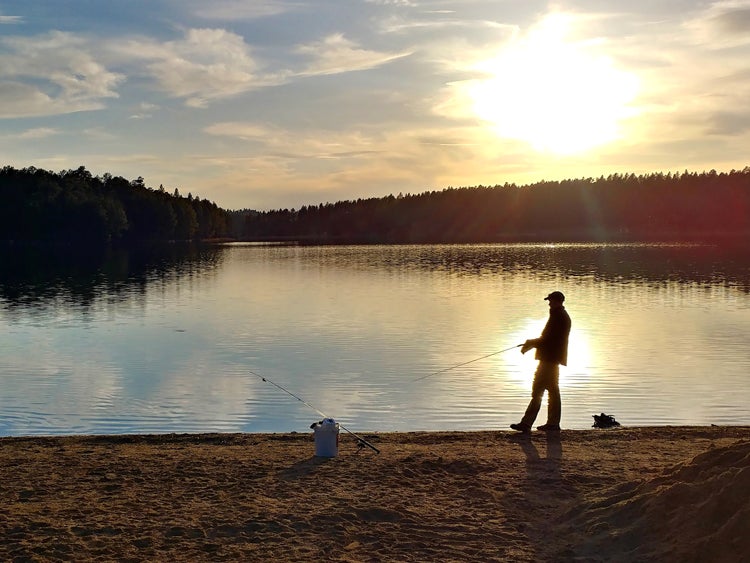
Fishing at Stockade Lake image from The Dyrt camper Kari T.
With four picturesque lakes, Custer State Park is a perfect place to embrace lake life. Each lake offers different amenities and scenery.
Sylvan Lake is Custer State Park’s oldest and most iconic lake. It is great for swimming, kayaking and paddleboarding. Only electric motors are allowed on the lake. Sylvan Lake is also the starting point for many hiking trails in the Black Hills.
It is the busiest lake in the park, meaning parking lots can fill up by the afternoon during the height of the summer season.
Stockade Lake is the largest lake in Custer State Park. It is the only lake within the park that allows all types of boats. It’s your go-to for finding a tucked away fishing spot, picking up a little speed on the water or just paddling more miles in your canoe.
Legion Lake is the second largest lake in the park. It allows the use of paddle craft and boats with electric motors only. It is great for swimming or simply stringing together a flotilla of kayaks and floating all afternoon. A one-mile hiking trail loops around the lake, and one of the park’s historic lodges offers beverages and snacks at a dog-friendly patio by the water.
Center Lake, the smallest of Custer State Park’s lakes, is tucked away in the north central part of the park. It allows only slow, non-wake boating, so it’s great for those looking for a more peaceful paddle. It also has a nice beach area for swimming.
Hiking
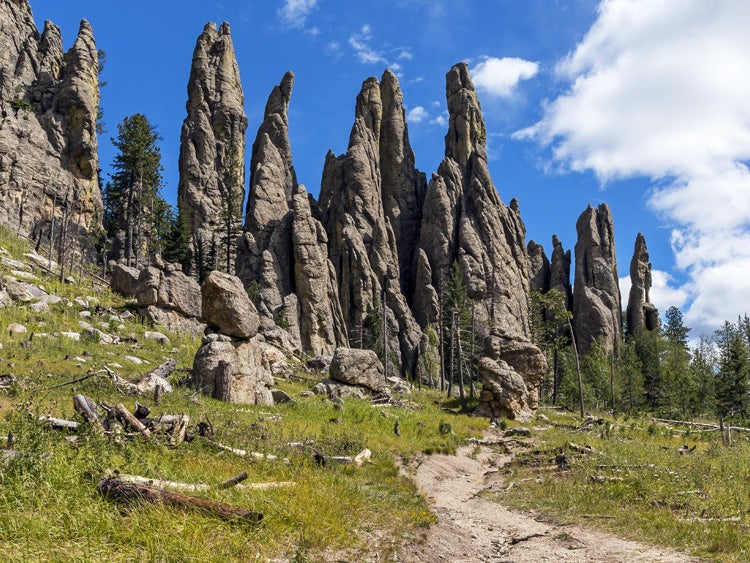
Trail to Cathedral Spires.
In addition to the diversity of the landscape, hikers in Custer State Park love how dog-friendly the park’s trails are. If you’re looking to take your furry best friend (or anyone else) on a hike in the park, you’ll find options that range from a quarter-of-a-mile to 22 miles in length. Visitors can pick up detailed maps and information from any of the park’s visitor centers. Some popular hikes include:
Lover’s Leap Trail is located across Highway 16A from the Peter Norbeck Outdoor Education Center. This 3-mile loop features beautiful wildflowers and the iconic Custer State Park sign that reads, “Custer State Park is a place where one can still be an unworried and unregimented individual and wear any old clothes and sit on a log and get his sanity back again.”
Sunday Gulch Trail is a 2.8-mile loop located by following the Sylvan Lake Shore Trail to the backside of the lake’s dam. The trail offers rugged granite terrain and beautiful park vistas. It is closed during the winter due to icy conditions.
Cathedral Spires Trail begins 2.5 miles east of Sylvan Lake on Needles Highway. It is an out-and-back trail, 1.5 miles each way for a 3-mile round trip. You’ll get up-close views of the stunning Cathedral Spires rock formations at the end of the trail. Parking at the trailhead is limited.
Not ready to hit the trail on your own? Take a guided hike with someone who can teach you about the park. Custer State Park offers guided hikes throughout the year on several different trails. Each year there is also a “first day” hike on January 1 and a few snowshoeing events in the winter.
Join Custer State Park for a Year of Events
Each year, Custer State Park offers an array of events to help visitors enjoy the park even more. Specifics times, locations and availability for these events can be found at any park visitor center and on the park’s website.
Naturalist Talks and Activities: Naturalists in the park offer talks on everything from starry night skies and canoeing basics to wildlife and more. Activities such as blue bird and bat box workshops are also available during the year.
Buffalo Roundup & Arts Festival: In late September each year, cowboys and cowgirls round up and drive the Custer State Park bison herd of about 1,300. The park uses this event to take stock of the herd for important wildlife management decisions, and visitors get a real Western experience. An arts festival also takes place in the park that weekend with many craft and food booths.
Custer State Park Trail Challenge: Each year, Custer State Park selects eight trails within the park for this fun challenge. Participants must hike each of the eight trails, find the unique bronze medallion along each route and get a rubbing of it in their challenge booklet. Once a participant collects all eight rubbings, she can bring the booklet into any visitor center for a special prize. The challenge runs from May into September.
In 2019, Custer State Park is also celebrating its centennial with a variety of events throughout the year, including a coloring contest and a poet challenge.

Sylvan Lake Camp image from The Dyrt camper Jaclyn D.
Campgrounds are located throughout the park and include: Blue Bell, Center Lake, Game Lodge, Grace Coolidge, Legion Lake, Stockade Lake North, Stockade Lake South, Sylvan Lake and French Creek Horse Camp. Fees range from $19 to $35 per night depending on the site. Blue Bell, Game Lodge, Stockade Lake South, and French Creek Horse Camp all also offer camping cabins that sleep four to five people for $50.
RV dump stations can be found at Game Lodge and French Creek Horse Camp. All sites except Stockade Lake South and Sylvan Lake can accommodate large trailers. All sites have showers and either flush or vault toilets available.
Camping reservations for Custer State Park can be made one year in advance online or by calling (800) 710-2267.
There is a $7.70 non-refundable reservation fee for non-residents and a $2 fee for phone reservations. Same-day reservations can be made at Center Lake Campground beginning at 6 a.m. daily. Full payment must be made at the time of reservation.
If you’re looking to get a bit more off the beaten path, primitive camping is allowed in the park’s French Creek Natural Area. Backpackers can camp anywhere along the canyon bottom. Open fires are not allowed. Self-registration is required at the trailhead, and the fee is $7 per person, per night.
More Information on Custer State Park
For information when you arrive at the park, stop by the Custer State Park Visitor Center located at the junction of Wildlife Loop Road and Highway 16A. It is open from 8 a.m. to 8 p.m. Memorial Day through Labor Day with shortened hours throughout the rest of the year. The Peter Norbeck Outdoor Education Center located on Highway 16A near the State Game Lodge also has park information and interpretive programs.
Find the most up-to-date information about Custer State Park and its facilities’ hours on the park’s website and the Custer State Park Resort website.
An entrance license is required for all Custer State Park visitors. A one-week pass is $20 per vehicle or $10 per motorcycle. An annual pass, which is good for all state parks in South Dakota, is $30 per vehicle and $15 for a second vehicle.
A transferable park pass is $65 per vehicle. Passes can be purchased at any entrance station.
The Dyrt is the only camping app with all of the public and private campgrounds, RV parks, and free camping locations in the United States. Download now for iOS and Android.Popular Articles:
Articles on The Dyrt Magazine may contain links to affiliate websites. The Dyrt receives an affiliate commission for any purchases made by using such links at no additional cost to you the consumer.

